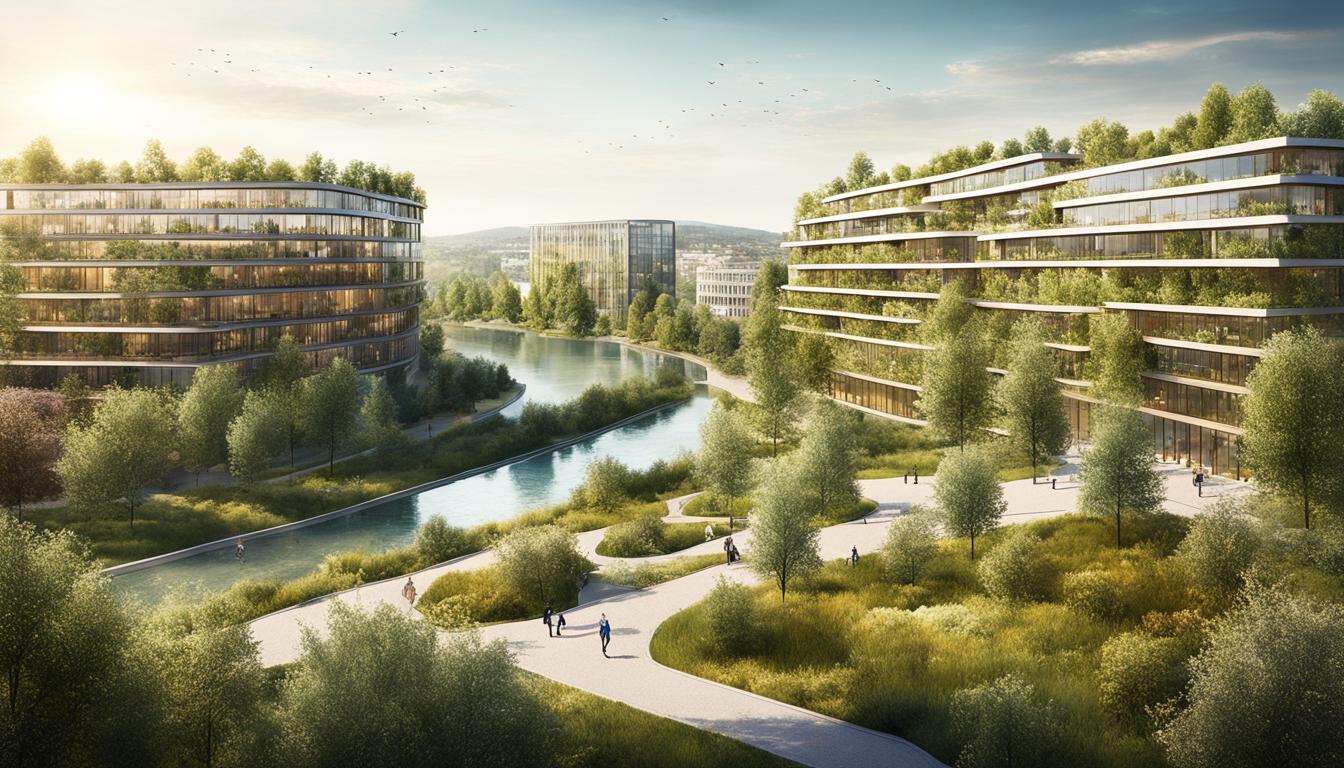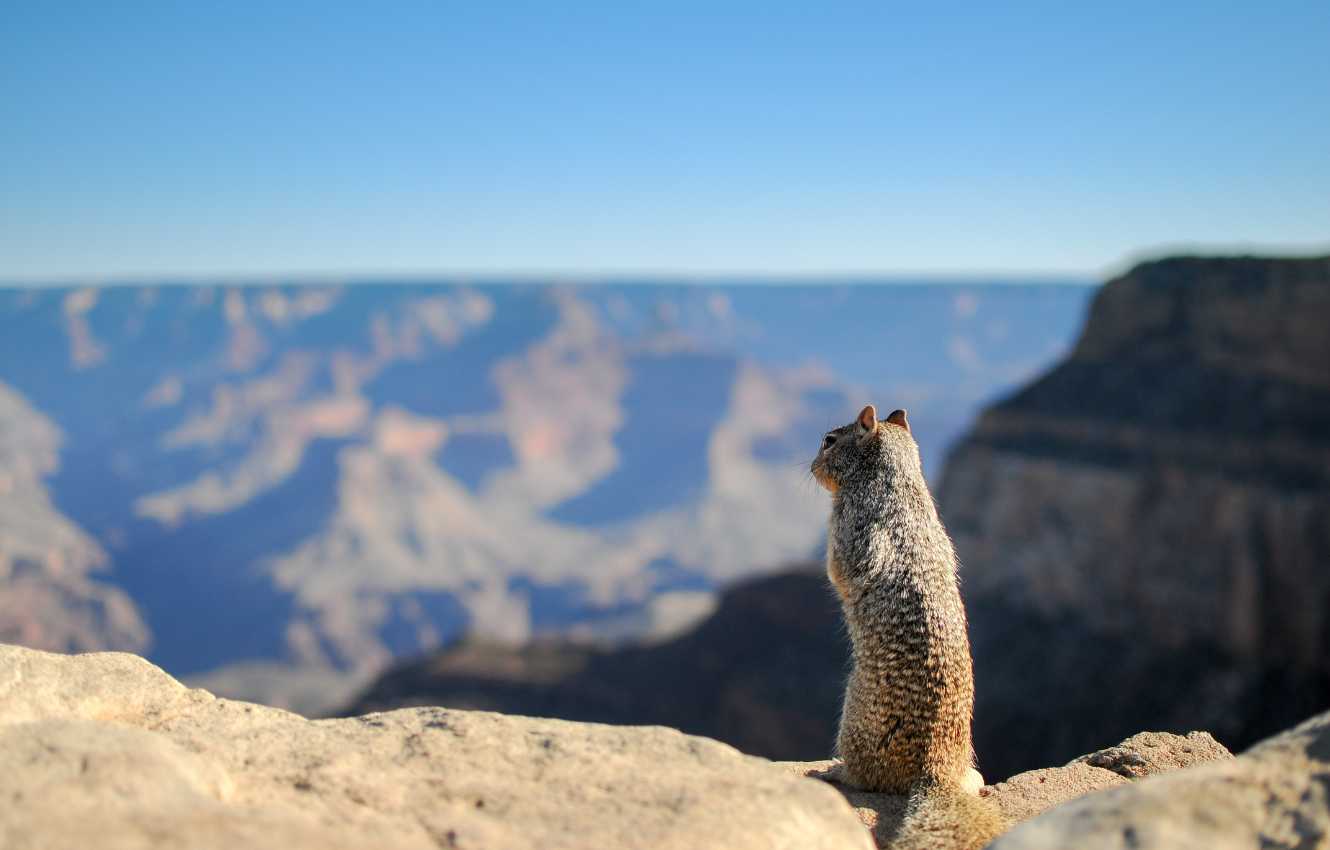India Biodiversity and the Built Environment
Welcome to a fascinating exploration of the intricate relationship between India’s biodiversity and the built environment. Did you know that over 50% of the human population currently lives in cities, according to a World Bank report? This number continues to grow every day, posing significant challenges for sustainable development and conservation efforts.
As urbanization expands, our built environment encroaches upon natural ecosystems and habitats surrounding cities. The nonprofit Ellen MacArthur Foundation warns that our current “take-make-waste” model puts significant pressure on biodiversity, with the built environment responsible for almost 30% of global loss.
This article delves into the effects of urbanization on biodiversity, specifically focusing on the case of Mumbai, India. It explores the impact of mangrove loss, conservation efforts in the city, the presence of wildlife in urban areas, and the social and environmental inequities that exist in urban spaces.
Join us on this journey to understand the importance of incorporating biodiversity considerations into urban planning and design, and discover how we can create a sustainable and harmonious coexistence between nature and development.
Key Takeaways:
- Urbanization poses significant threats to biodiversity and ecosystem services.
- The loss of mangroves in Mumbai has serious consequences for carbon sequestration, coastal erosion prevention, and marine life habitats.
- Environmental activists in Mumbai are raising awareness of the negative impacts of infrastructure projects on mangroves.
- While urbanization often leads to biodiversity loss, some species can thrive in built environments.
- Socio-economic disparities in cities contribute to environmental inequities.
The Effects of Urbanization on Biodiversity
As we create systems and structures in our built environment, we are building on top of organisms and their homes, forcing many species to suffer from habitat fragmentation, higher wildlife mortality rates, and forced human-wildlife interactions. Biodiversity loss does not only affect ecosystems, but humans as well. Ecosystem services represent the value we place on nature through their economic, recreational, and biological benefits. The value of ecosystem services currently stands at $44 trillion, over half of the global GDP. The built environment is currently responsible for nearly 30% of global biodiversity loss. This is causing a catastrophic impact on our ecosystems and the services they provide.
The Impact of Urbanization on Biodiversity
- Habitat Fragmentation: The expansion of cities and infrastructure breaks up natural habitats, isolating populations and preventing gene flow among species.
- Wildlife Mortality Rates: Collisions with vehicles, predation by domestic pets, and exposure to pollutants are common causes of wildlife mortality in urban areas.
- Human-Wildlife Interactions: Increased proximity between humans and wildlife in urbanized areas can lead to conflicts, as animals may scavenge for food, damage property, or pose risks to human safety.
“Biodiversity loss does not only negatively impact ecosystems, but also has consequences for human well-being and the economy.”
It is essential to recognize the significant role that urbanization plays in biodiversity loss and take proactive measures to mitigate its effects. By implementing sustainable urban planning strategies, such as creating wildlife corridors and green spaces, we can mitigate habitat fragmentation and promote the coexistence of humans and wildlife. Additionally, integrating educational initiatives and raising awareness about the importance of biodiversity can foster a sense of responsibility and encourage individuals to play an active role in protecting and preserving the natural world.
The Case of Mumbai, India
Mumbai, a bustling metropolis with its dense population and rapid urbanization, is currently facing significant threats to its rich ecosystems and unique biodiversity. The city has witnessed the loss of nearly 40% of its mangroves between 1991 and 2001, primarily due to the expansion of infrastructure projects and indiscriminate waste dumping into the sea.
This decline in mangrove cover has resulted in an alarming loss of crucial ecosystem services. Mangroves play a vital role in carbon sequestration, acting as natural carbon sinks. With their disappearance, the city is losing an efficient natural solution to mitigate climate change. Additionally, mangroves act as a barrier against coastal erosion, preventing the encroachment of seawater into delicate coastal habitats. The loss of their protective presence exacerbates the issue, leaving Mumbai more vulnerable to the damaging effects of coastal erosion.
The mangroves of Mumbai also serve as breeding grounds and nurseries for many species of marine life. Their destruction disrupts the delicate balance of the marine ecosystem, affecting the abundance and diversity of marine species. The absence of healthy mangroves can lead to a decline in fish populations and the subsequent collapse of coastal fisheries.
Furthermore, mangroves act as natural buffers against floods, absorbing excess water during heavy rainfall and reducing the impact of flooding in coastal areas. Without the protective cover of mangroves, Mumbai becomes increasingly susceptible to floods, endangering the lives and properties of its residents.
Another critical ecosystem service provided by mangroves is their ability to minimize the urban heat island effect. The dense, concrete structures of cities like Mumbai retain and radiate heat, leading to higher temperatures compared to surrounding rural areas. Mangroves help mitigate this effect by providing shade and cooling through evapotranspiration.
The Aesthetic Value of Mangroves
Beyond their functional significance, mangroves hold immense aesthetic value, shaping the unique landscape of Mumbai. Their lush greenery, interwoven with intricate root systems submerged in brackish water, creates a visually captivating environment. The decline of mangroves robs the city of a natural aesthetic that has become an integral part of its identity.
| Ecosystem Services provided by Mangroves in Mumbai | Effects of Mangrove Loss |
|---|---|
| Carbon sequestration | Inability to effectively mitigate climate change |
| Coastal erosion prevention | Increased vulnerability to coastal erosion |
| Breeding habitats for marine life | Decline in marine species populations |
| Flood protection | Heightened risk of flooding in coastal areas |
| Reduction of urban heat island effect | Intensified urban heat island effect |
| Aesthetic value | Loss of unique natural landscape |
It is crucial to recognize the multifaceted impacts of mangrove loss in Mumbai. The degradation of these ecosystems not only affects the immediate areas but also has far-reaching consequences for the entire city. Urgent action is needed to conserve and restore mangroves in Mumbai to safeguard its ecosystem services, protect marine life, mitigate flooding risks, and maintain the city’s unique beauty.
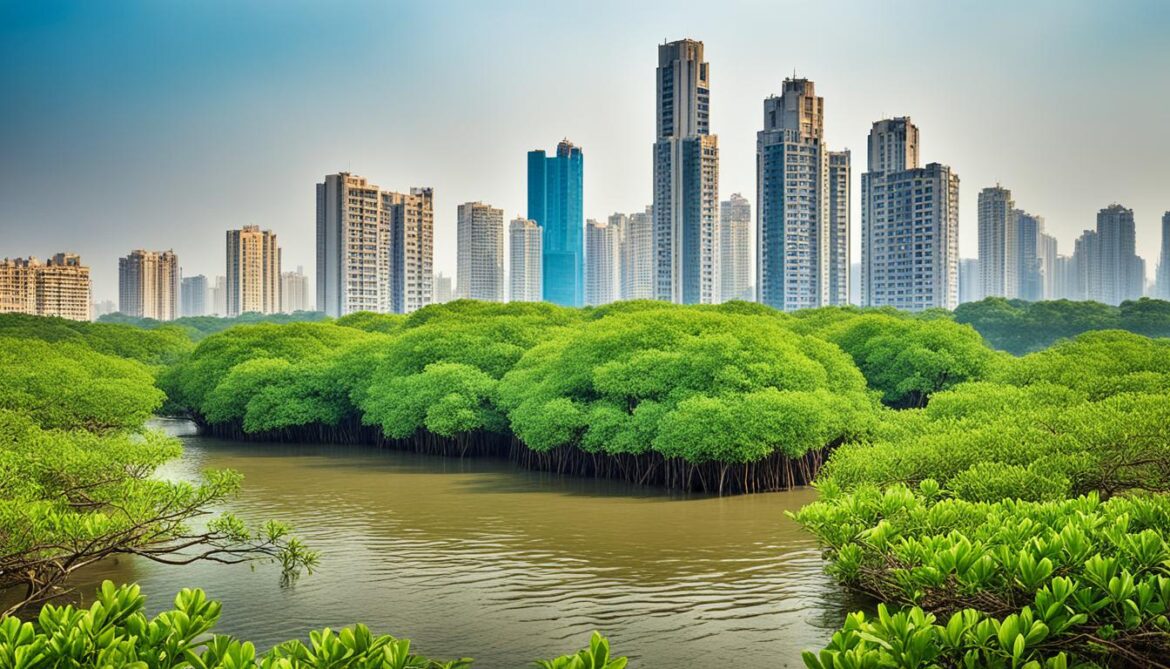
The Impact of Mangrove Loss in Mumbai
The loss of mangroves in Mumbai has had far-reaching consequences, leading to the depletion of several crucial ecosystem services. Mangroves play a vital role as a carbon sink, absorbing carbon dioxide from the atmosphere and mitigating climate change. They also act as a natural barrier against coastal erosion and saltwater intrusion, protecting the coastline from the damaging effects of waves and sea-level rise.
Furthermore, mangroves provide essential habitats for a diverse range of marine life. These ecosystems serve as breeding grounds, spawning sites, and nurseries for numerous fish species, supporting their populations and contributing to the overall health of the marine ecosystem. The loss of mangroves jeopardizes these critical habitats and disrupts the delicate balance of coastal ecosystems, potentially leading to a decline in fish populations and the loss of biodiversity.
In addition to their ecological significance, mangroves offer essential flood protection for coastal communities. The intricate root systems of mangroves act as natural barriers, reducing the impact of storm surges and flooding during periods of extreme weather events. The destruction of mangroves leaves coastal homes and infrastructure more vulnerable to the destructive forces of floods and storms.
Moreover, mangroves play a crucial role in mitigating the effects of urban heat islands. The dense foliage of mangrove forests provides shade and evaporative cooling, reducing the overall temperature in urban areas. By minimizing the intensity of heat islands, mangroves contribute to creating more comfortable and livable environments, especially in densely populated cities like Mumbai.
Aside from their ecological functions, the aesthetic value of mangroves cannot be understated. The lush green canopies, intricate root systems, and interplay between land and water create a visually stunning landscape that is inherently part of Mumbai’s identity. The loss of mangroves not only diminishes the natural beauty of the city but also erodes its cultural and ecological heritage.
“The destruction of mangroves not only threatens the resilience of coastal ecosystems but also puts the livelihoods and well-being of coastal communities at risk,” said environmental scientist Dr. Maya Patel.
The Economic Value of Mangroves
Besides their ecological importance, mangroves also have significant economic value. A study conducted by the World Wildlife Fund (WWF) estimated that mangrove forests provide ecosystem services worth approximately $194,000 per hectare per year, emphasizing the indispensable role they play in sustaining local economies.
Table: Economic Value of Mangroves
| Ecosystem Service | Value (USD per hectare per year) |
|---|---|
| Carbon sequestration | $1,100 – $5,800 |
| Coastal protection | $4,500 – $9,800 |
| Fisheries | $1,400 – $31,200 |
| Tourism and recreation | $150 – $900 |
“The economic value of mangroves provides a compelling argument for their conservation. Protecting and restoring mangrove ecosystems is not only an investment in nature but also in the long-term sustainability of coastal communities,” said marine biologist Dr. Siddharth Mehta.
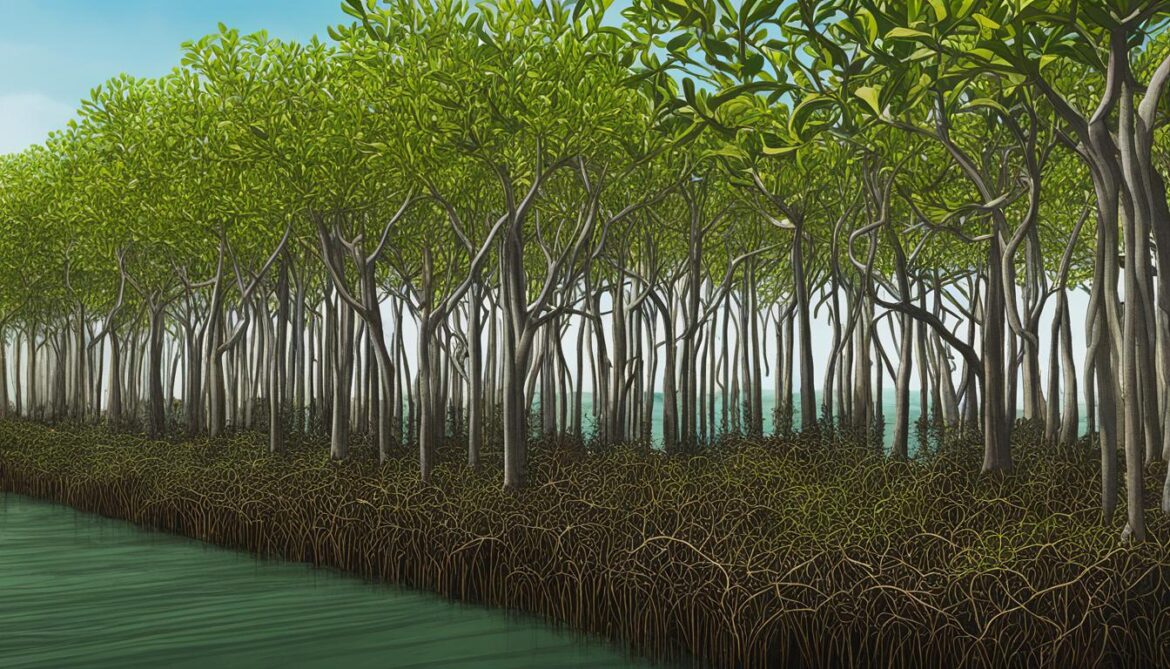
The image above visually represents the exquisite beauty and importance of mangroves in Mumbai. The intricate network of roots and vibrant green foliage exemplify the unique characteristics of these coastal forests.
Conservation Efforts in Mumbai
Environmental activists in Mumbai are taking a stand to protect the city’s valuable mangroves and raise awareness about the detrimental environmental impacts of infrastructure projects. Through exhibitions and collective action, these passionate individuals are working tirelessly to advocate for mangrove conservation and more sustainable approaches to urban planning and design.
“The decline of mangroves in Mumbai is a cause for concern. We need to ask ourselves if development should come at the cost of our environment,” says Ravi Sharma, a prominent environmental activist. “We believe that it is crucial to preserve the natural ecosystems that provide numerous benefits to both wildlife and human communities.”
Mangroves play a vital role in providing important ecosystem services such as coastal protection, carbon sequestration, and habitats for diverse marine life. However, increasing infrastructure projects and waste dumping have resulted in the loss of nearly 40% of Mumbai’s mangroves between 1991 and 2001.
In response, environmental activists have organized exhibitions to showcase the value of mangroves and highlight the urgent need for their preservation. These exhibitions educate the public about the environmental impacts of infrastructure projects and the significance of mangroves in maintaining the overall ecological balance of the region.
Furthermore, these activists actively engage with policymakers and local communities to promote sustainable alternatives in urban planning and design that prioritize the preservation and restoration of mangrove ecosystems. They advocate for greener infrastructure projects that mitigate environmental impacts and enhance the city’s resilience to climate change.
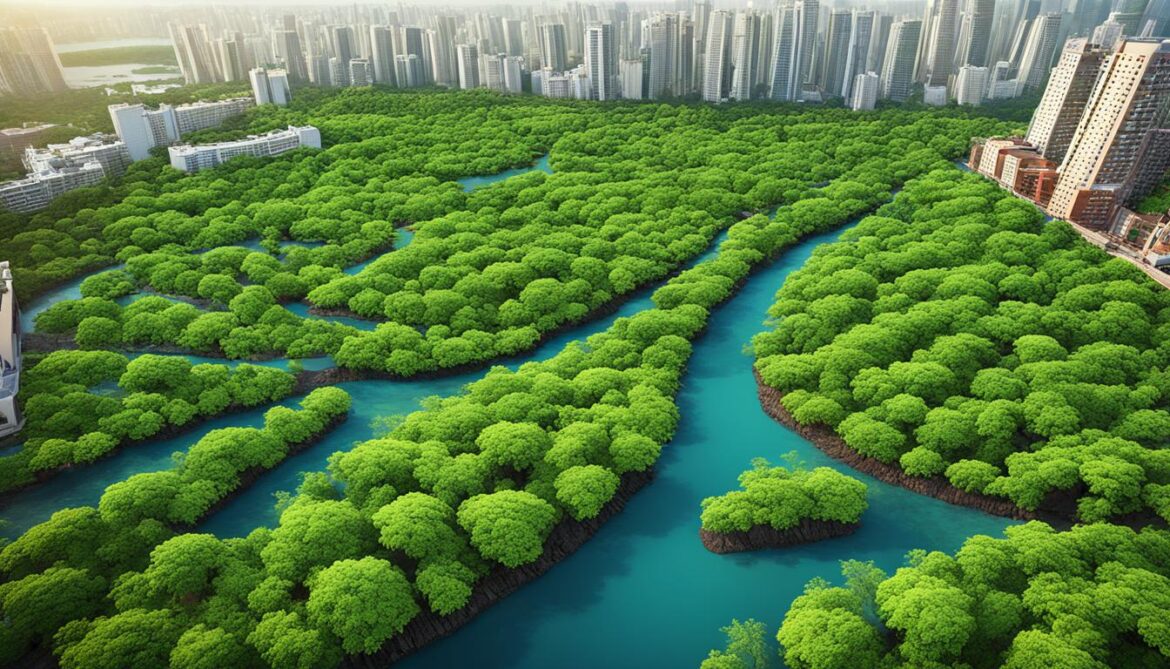
Wildlife in the Built Environment
Despite the negative impact of urbanization on biodiversity and ecosystem health, there are certain species that have successfully adapted to our built environment. These generalist species have the ability to thrive in urban areas by taking advantage of anthropogenic food sources and the absence of predators.
Urbanization often creates new habitats and food sources for wildlife in urban areas, leading to an influx of species that may not be native to the region. This phenomenon, known as species invasions, can have both positive and negative consequences. On one hand, non-native species can contribute to the diversity of urban wildlife. On the other hand, they can pose threats to native species populations and disrupt the ecological balance.
Generalist species, such as pigeons and raccoons, have successfully adapted to urban environments due to their ability to tolerate a wide range of conditions and exploit available resources. They are opportunistic feeders, capable of thriving on the food waste generated by human activities. However, their presence in urban areas can lead to forced human-wildlife interactions, such as scavenging for food in garbage bins, and can sometimes result in nuisance and conflicts.

“While some species adapt well to the built environment, their presence can result in challenges such as forced human-wildlife interactions and the displacement of native species populations.”
These generalist species often outcompete native species for resources, leading to a decline in native populations. This displacement can have a cascading effect on the ecosystem, as native species play crucial roles in pollination, seed dispersal, and maintaining ecological balance.
To ensure a harmonious coexistence between wildlife and urban development, it is important to implement strategies that support both native species and generalist species. This can be achieved through the conservation of native habitats, the creation of green spaces within cities, and the incorporation of wildlife-friendly designs into urban planning.
The Displacement of Native Species Populations
The displacement of native species populations by generalist species is a growing concern in urban areas. As generalist species thrive in urban environments, they can outcompete and displace native species, leading to a decline in biodiversity.
| Negative Effects of Generalist Species | Potential Consequences |
|---|---|
| Outcompeting native species for resources | Reduction in native species populations |
| Disruption of ecological balance | Loss of ecosystem services |
| Introduction of diseases | Health risks to humans and wildlife |
Efforts should be made to protect and restore natural habitats within urban areas to support the survival of native species. This can include the creation of wildlife corridors, rewilding initiatives, and the integration of green infrastructure into urban planning. By promoting the coexistence of native and generalist species, we can maintain healthy ecosystems and preserve biodiversity in our built environment.
Social and Environmental Inequities in Urban Areas
Socio-economic disparities in urban areas contribute to significant environmental inequities. Low-income communities face numerous challenges such as intense urban heat island effects, limited tree canopy cover, higher levels of air pollutants, and restricted access to high-quality green spaces. These disparities have a profound impact on the well-being of residents and their interactions with nature and wildlife, which, in turn, affect conservation efforts.
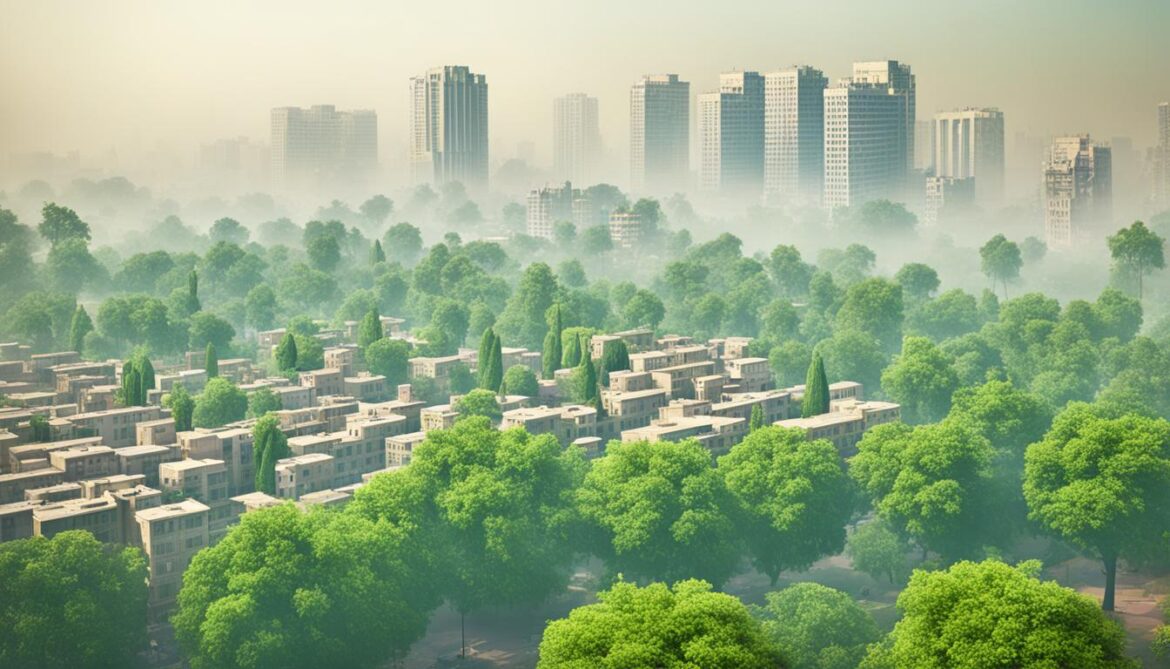
Low-income communities often bear the brunt of urban heat island effects, where the built environment and lack of green spaces amplify temperatures in densely populated areas. The absence of sufficient tree canopy cover further exacerbates this issue, reducing natural shade and increasing heat-trapping surfaces. As a result, residents experience heightened discomfort, increased energy demands for cooling, and greater vulnerability to heat-related health risks.
Additionally, low-income communities tend to face higher levels of air pollutants, stemming from numerous sources such as industrial facilities, transportation emissions, and proximity to hazardous infrastructure. This leads to compromised air quality, which can have detrimental effects on respiratory health and overall well-being.
Moreover, limited access to high-quality green spaces deprives individuals in low-income communities of opportunities for recreation, relaxation, and the numerous benefits associated with nature. Green spaces offer mental and physical health benefits, promote social cohesion, and provide a refuge from the stress and noise of urban living. The lack of such access not only hinders the quality of life but also alienates communities from the conservation efforts required to protect and restore the natural environment.
“Socio-economic disparities in urban areas contribute to significant environmental inequities, including unequal exposure to the detrimental effects of urbanization and limited access to nature.”
Addressing Environmental Inequities: Strategies for Change
To address these socio-environmental disparities, it is crucial to prioritize equitable urban planning and distribution of resources. The following strategies can be instrumental in promoting a more inclusive and sustainable urban environment:
- Investing in green infrastructure: Implementing green infrastructure projects, such as urban parks, green roofs, and community gardens, in underserved areas can help increase tree canopy cover, mitigate urban heat island effects, and improve air quality.
- Facilitating affordable housing near green spaces: Ensuring the availability of affordable housing options in proximity to parks and green spaces can enhance access for low-income communities and promote healthier living environments.
- Promoting community engagement and education: Encouraging community participation in decision-making processes and providing environmental education can empower residents to advocate for their rights to a healthy and sustainable environment.
- Collaborating with local organizations: Partnerships between local government, non-profit organizations, and community groups can create synergistic efforts to address environmental inequities and design initiatives that cater to the specific needs and aspirations of underserved communities.
By adopting these strategies, urban areas can work towards bridging the socio-environmental gaps and creating more equitable and sustainable communities for all residents.
The Issue of Pigeons in Urban Areas
Pigeons are a well-known sight in many urban areas, but they can also be a major nuisance. These birds, often considered invasive species, have adapted to urban environments and thrive in built-up areas. However, their presence can create various problems, ranging from unsanitary conditions to potential health risks.
Large populations of pigeons can lead to unsanitary conditions in urban areas. Their droppings accumulate on buildings, walkways, and public spaces, creating an unclean and unpleasant environment. Not only is this visually unappealing, but it can also pose health risks.
“Pigeon droppings can carry bacteria, viruses, and fungi that can cause respiratory diseases and other infections in humans,” says Dr. Sarah Johnson, a wildlife biologist. “Direct contact with pigeon feces or inhalation of dried droppings can lead to health issues, particularly for those with weakened immune systems or respiratory conditions.”
Poor waste management in low-income communities can exacerbate the pigeon problem. When waste is not properly disposed of or stored, it attracts pigeons looking for food sources. They gather around overflowing bins and garbage dumps, further contributing to the issue.
To address the problems caused by urban pigeons, proper waste management and sanitation systems are essential. Implementing effective waste management practices, such as regular collection and proper disposal of waste, can help reduce the availability of food sources for pigeons. In addition, educating communities about the importance of waste management and providing accessible waste disposal facilities can make a significant difference in mitigating the pigeon issue.
Planning for Biodiverse Urban Environments
To address the challenges of biodiversity loss in urban areas, it is essential to plan for compact and biodiverse urban environments. By incorporating green infrastructure, such as parks, green roofs, and urban forests, into urban planning, we can create spaces that support wildlife habitats, promote biodiversity, and provide essential ecosystem services.
Compact urban environments play a crucial role in ensuring efficient land use and minimizing the impact of urban expansion on natural ecosystems. By designing cities with a smaller physical footprint, we can preserve more open spaces for biodiversity conservation. This approach also reduces the fragmentation of habitats and allows for the movement of species through interconnected green corridors.
Green infrastructure, including the use of green roofs, vertical gardens, and urban forests, helps to restore biodiversity in urban areas. These elements provide valuable habitats for birds, insects, and other wildlife, as well as contribute to the overall well-being of urban dwellers. Green spaces also mitigate the effects of climate change by reducing the urban heat island effect, improving air quality, and absorbing carbon dioxide.
“Incorporating green infrastructure into urban planning is not only essential for biodiversity conservation but also for creating resilient and sustainable cities that prioritize the well-being of both humans and nature.” – Dr. Emily Green, Environmental Scientist
Urban planning that considers biodiversity conservation as a priority has numerous benefits for both urban residents and the environment. It enhances the quality of life by providing recreational opportunities, improving mental health, and fostering a sense of connection with nature. Additionally, green spaces in cities improve the aesthetic appeal and attractiveness, attracting tourists and boosting the local economy.
By integrating compact urban environments, biodiversity conservation, green infrastructure, and urban planning, we can create cities that are not only environmentally sustainable but also socially and economically vibrant. Planning for biodiverse urban environments ensures that future generations can enjoy the beauty and benefits of nature while living in thriving urban centers.

Benefits of Planning for Biodiverse Urban Environments
| Benefits | Description |
|---|---|
| Enhanced Biodiversity | Creation of habitats and corridors for wildlife, promoting species diversity. |
| Ecosystem Services | Provision of clean air, water filtration, and carbon sequestration. |
| Improved Mental Health | Access to green spaces reduces stress levels and improves overall well-being. |
| Climate Change Mitigation | Reduction of urban heat island effect and absorption of carbon dioxide. |
| Recreation and Tourism | Opportunities for outdoor activities and attraction for visitors. |
The Importance of Biodiversity for a Sustainable Future
Biodiversity plays a crucial role in maintaining a sustainable future for our planet. As one of the planetary boundaries, it helps regulate the delicate operating system of the Earth. However, the loss of biodiversity due to human activities poses significant threats to ecosystem stability and human well-being.
While quantifying and defining global biodiversity loss is a challenging task, the evidence suggests that human actions are exerting exceptional pressure on biodiversity. This loss of species and ecosystems can have severe consequences, impacting the overall stability of our natural systems and the well-being of both wildlife and humans alike.
“The loss of biodiversity is not just an environmental issue; it is a societal and economic challenge. The services that ecosystems provide, such as clean air, water, and food production, are critical for human well-being and our future sustainability.”
Biodiversity loss disrupts the intricate web of interconnections within ecosystems. It threatens the productivity and functioning of ecosystems and hampers their ability to provide essential services, such as pollination, nutrient cycling, and climate regulation. Ultimately, this has far-reaching consequences for human societies, including the potential collapse of essential ecosystems that support our way of life.
It is essential to recognize the value of biodiversity as a vital asset for our sustainable future. By conserving and restoring biodiversity, we can foster ecosystem resilience, enhance human well-being, and sustain the provision of critical ecosystem services.
The Benefits of Biodiversity for Human Well-Being
Biodiversity provides numerous benefits to human well-being, supporting our physical, mental, and social health:
- Promotes cleaner air and water by filtering pollutants
- Enhances food security through pollination and diverse agricultural systems
- Contributes to medical advancements through the discovery of new drugs and treatments
- Supports cultural and recreational activities, such as nature-based tourism
- Improves mental health and well-being through exposure to green spaces
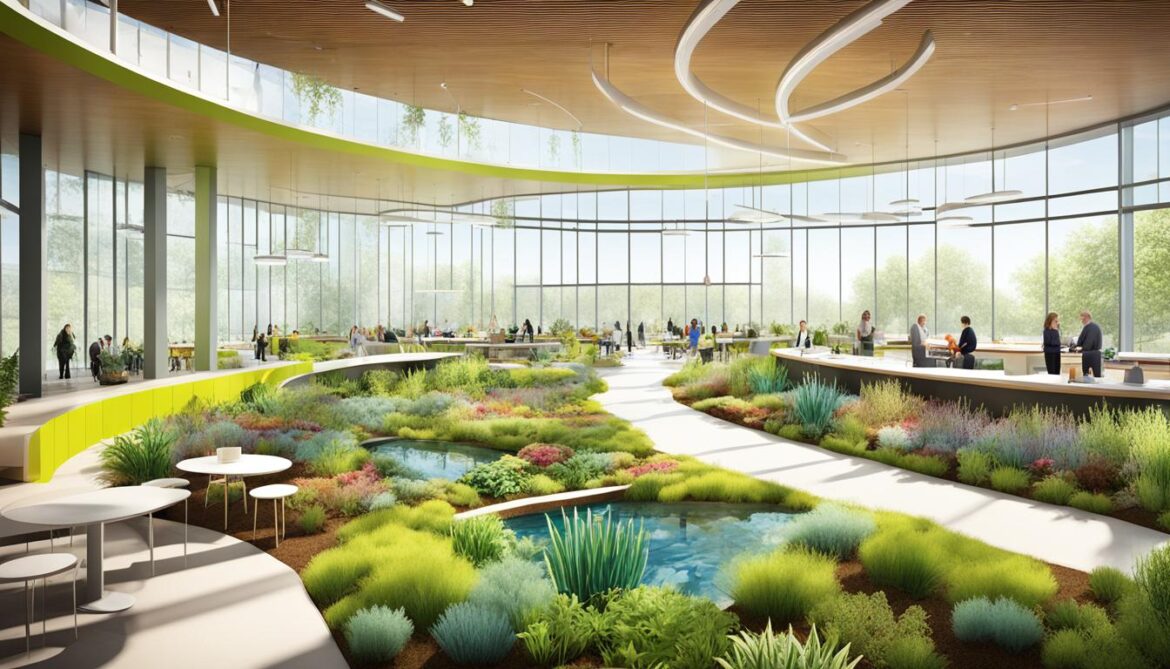
In summary, biodiversity is essential for maintaining ecosystem stability and human well-being. Preserving and restoring biodiversity is not only crucial for the sustainability of our planet but also for securing a prosperous and harmonious future for generations to come.
| Impact of Biodiversity Loss | Consequences |
|---|---|
| Reduced pollination | Decline in crop yields and food scarcity |
| Loss of keystone species | Disruption of entire ecosystems and ecological cascades |
| Decreased genetic diversity | Lower resilience to environmental changes and increased vulnerability to diseases |
| Loss of habitat | Displacement and extinction of species |
Reviving Architecture for Biodiversity Conservation
Architecture plays a crucial role in shaping the built environment and has a significant impact on biodiversity and the environment as a whole. As we strive for sustainable development, it is essential for architects and planners to consider biodiversity in their designs to create a more environmentally friendly and socially responsible built environment.
By integrating regional planning principles and sustainable development practices into architectural designs, we can create spaces that promote biodiversity conservation and enhance the overall well-being of both humans and the natural world. This involves incorporating green infrastructure, such as parks, urban forests, and green roofs, into our urban landscapes.
“Architecture should be rooted in its cultural context and embrace diversity to create a harmonious coexistence between nature and built structures.”
One approach to revive architecture for biodiversity conservation is by reclaiming and revitalizing vernacular architecture. Vernacular architecture refers to traditional building techniques and designs that are deeply rooted in local culture and natural surroundings. Reviving these traditional practices not only helps preserve cultural diversity but also incorporates eco-friendly materials and design principles that align with sustainable development goals.
| Reviving Architecture for Biodiversity Conservation | Benefits |
|---|---|
| Promoting sustainable development | – Reducing environmental impact – Enhancing energy efficiency – Improving resource management |
| Preserving cultural diversity | – Honoring local traditions – Incorporating cultural values into designs – Celebrating architectural heritage |
| Creating inclusive and sustainable built environments | – Designing spaces for all members of society – Enhancing social cohesion and well-being – Providing access to nature and green spaces |
Embracing cultural diversity is another essential aspect of reviving architecture for biodiversity conservation. By acknowledging and incorporating diverse cultural values, architectural designs can reflect the unique identity and aspirations of local communities. This inclusive approach helps create a sense of belonging and fosters a deeper connection between people and their natural surroundings.
Furthermore, engaging with local stakeholders, including indigenous communities, can provide invaluable knowledge and insights into sustainable building practices that have been passed down through generations. By merging traditional wisdom with innovative solutions, architects can create designs that integrate seamlessly into the natural environment while supporting biodiversity conservation efforts.
Reviving architecture for biodiversity conservation requires a holistic approach that encompasses sustainable development, regional planning, and cultural diversity. By combining these principles, architects and planners can shape the built environment to not only meet the needs of today but also ensure a sustainable future for generations to come.
Key Takeaways:
- Architects and planners play a crucial role in promoting biodiversity conservation through the built environment.
- Integrating regional planning and sustainable development principles into architectural designs can enhance biodiversity and environmental sustainability.
- Reviving vernacular architecture and embracing cultural diversity contribute to biodiversity conservation and create a more inclusive built environment.
- Engaging with local stakeholders, including indigenous communities, can provide valuable insights into sustainable building practices.
- By considering biodiversity in architectural designs, we can create a harmonious coexistence between nature and built structures.
Conclusion
The synergy between India’s rich biodiversity and sustainable urban development is essential for a greener future. By incorporating biodiversity conservation into urban planning and design, we can create a built environment that supports wildlife habitats, enhances ecosystem services, and promotes environmental sustainability.
Prioritizing biodiversity in our cities is crucial to ensure a harmonious coexistence between nature and development. Sustainable urban development practices, such as the incorporation of green infrastructure and the protection of natural habitats, play a vital role in maintaining and enhancing biodiversity within urban areas.
In our efforts to build sustainable cities, we must recognize the numerous benefits that biodiversity provides, including improved air and water quality, climate regulation, and overall enhanced quality of life for city residents. By valuing and protecting our biodiversity, we can create cities that are not only environmentally sustainable but also socially and economically vibrant.
FAQ
How does urbanization affect biodiversity?
Urbanization can lead to habitat fragmentation, higher wildlife mortality rates, and forced human-wildlife interactions, resulting in a loss of biodiversity.
What are the impacts of mangrove loss in Mumbai?
The decline of mangroves in Mumbai has led to a loss of important ecosystem services such as carbon sequestration, coastal erosion prevention, breeding habitats for marine life, flood protection, reduction of urban heat island effect, and aesthetic value.
What conservation efforts are taking place in Mumbai?
Environmental activists are organizing exhibitions and raising awareness about the negative environmental impacts of infrastructure projects, advocating for more sustainable approaches to urban planning and design.
How does wildlife adapt to the built environment?
Generalist species are able to adapt and thrive in urban areas due to the availability of anthropogenic food sources and the lack of predators. However, their presence can lead to issues such as forced human-wildlife interactions and the displacement of native species populations.
What are the social and environmental inequities in urban areas?
Low-income communities often experience more intense urban heat island effects, less tree canopy cover, higher levels of air pollutants, and limited access to high-quality green spaces, impacting their association with nature and conservation efforts.
What is the issue with pigeons in urban areas?
Pigeons are considered invasive species and can create unsanitary conditions, transmit diseases to humans, and attract further problems with poor waste management in low-income communities. Proper waste management and sanitation systems are needed to address these issues.
How can we plan for biodiverse urban environments?
Planning for compact and biodiverse urban environments involves incorporating green infrastructure, such as parks, green roofs, and urban forests, to support wildlife habitats, promote biodiversity, and provide ecosystem services.
Why is biodiversity important for a sustainable future?
Biodiversity is a crucial part of the planet’s operating system, regulating ecosystem stability and providing numerous benefits to human well-being. Its loss can have severe consequences for both ecosystems and humanity.
How can architecture contribute to biodiversity conservation?
Architects and planners can consider biodiversity in their designs by promoting sustainable development and reviving vernacular architecture. Embracing cultural diversity can also contribute to biodiversity conservation and create a more inclusive and sustainable built environment.
How can we ensure a harmonious coexistence between nature and development?
By incorporating biodiversity conservation into urban planning and design, we can create a built environment that supports wildlife habitats, enhances ecosystem services, and promotes environmental sustainability.



